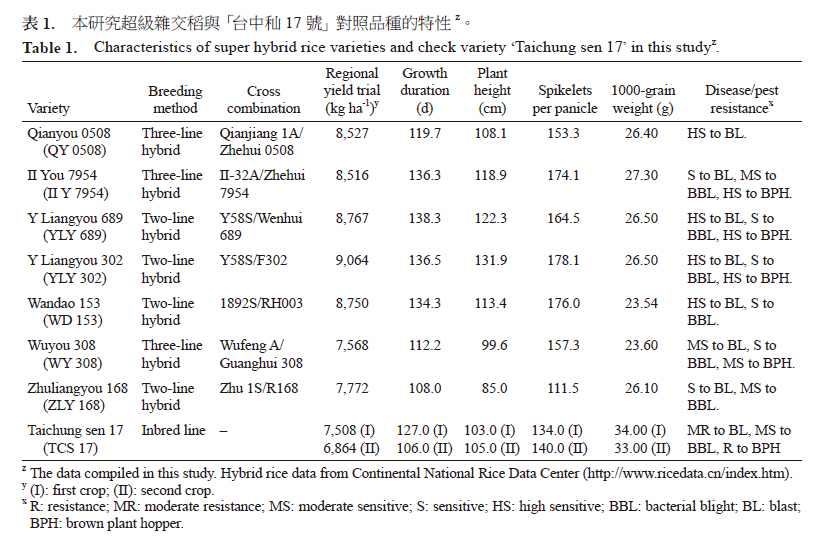All issues
Author:Woei-Shyuan Jwo*, Chung-Li Chen, Charng-Pei Li, Ming-Hsin Lai, Dong-Hong Wu, and Hsing-Mu Yen
Abstract:
Rice is the most widely grown and consumed staple crop in Taiwan. Increasing rice yield potential is eventually a major target in rice breeding programs and the use of heterosis is also a feasible strategy. The objective of this study was to evaluate growth characters and yield potential of the recently developed hybrid rice in Mainland China. Field trials were conducted for two cropping seasons using seven Chinese varieties including ‘Qianyou 0508’ (‘QY 0508’), ‘II You 7954’ (‘II Y 7954’), ‘Y Liangyou 689’ (‘YLY 689’), ‘Y Liangyou 302’ (‘YLY 302’), ‘Wandao 153’ (‘WD 153’), ‘Wuyou 308’ (‘WY 308’), ‘Zhuliangyou 168’ (‘ZLY 168’) and check variety ‘Taichung Sen 17’ (‘TCS 17’). The results of ANOVA revealed that rice agronomic characters and yield-related traits were significantly affected by different seedling number and plant varieties. Grain yield, yield components and agronomic traits of all imported rice were superior than indica check variety ‘TCS 17’. In addition, grain yield in the first cropping season of all tested varieties was higher than that in the second cropping season. The high yield of super hybrid rice is due to the increase in the total number of spikelet per plant (sink size). In the first cropping season, average grain yield of super hybrid rice was 20% and 5% higher than check variety ‘TCS 17’ in multiple and two-seedling treatment, respectively. In the second crop, average grain yield of super hybrid rice was 7% and 10% higher than check variety ‘TCS 17’ in multiple and two-seedling treatment, respectively. Comparison between two treatments of seedling number showed that yield performance of two plants per hill was inferior than multiple seedling mainly attributed to the lack of panicle number. These results indicate that increased spikelet number per panicle and maintained enough panicle number per meter square are a foundation to obtain higher yield potential for supper hybrid rice cultivated in Taiwan.
Key words:Super hybrid rice, Yield components
Download:![]() PDF Links
PDF Links
- 1. Development of Tractor-Mounted Seedling Transplanter for Sweet Potato
- 2. Synergistic Effect of Additional Gas on the Toxicity of Phosphine to Sitophilus oryzae and Sitophilus zeamais (Coleoptera: Dryophthoridae)
- 3. Effects of Temperature and Solar Radiation on Growth Traits and Plant Elements in Purple Leafy Sweet Potato

 Submit your manuscript
Submit your manuscript
 Guide for authors
Guide for authors